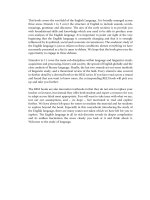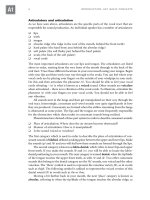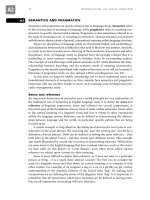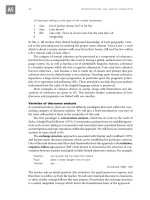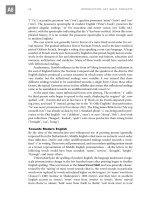Introdungcing English language part 26 ppsx
Bạn đang xem bản rút gọn của tài liệu. Xem và tải ngay bản đầy đủ của tài liệu tại đây (291.44 KB, 6 trang )
136 EXPLORATION: INVESTIGATING ENGLISH LANGUAGE
I once shot an elephant in my pajamas. How he got in my pajamas I’ll never know.
(Groucho Marx)
It said ‘For the sick’. (Child’s explanation for vomiting in the collection box at
the back of a church)
I’ll bring the picnic if it looks nice. (The problems of an existential ‘it’)
Dogs keep off the grass. (Addressed to literate dogs?)
Please remove your clothes when the cycle is complete. (At a coin-op laundry)
Nothing works faster than Anadin. (Overly honest drug company advertising slogan)
Child teaching expert to speak. (University seminar notice)
No smoking rooms available. (Hotel sign)
Slow children ahead. (Sign near school, Nottingham)
This door is alarmed! (Bus notice, Nottingham)
Dogs Trust Rehoming Centre. (Signpost in Cambridgeshire)
Cat’s eyes removed. (Yorkshire roadworks sign)
Explain (i.e. spoil) this old joke using a tree diagram:
‘I once knew a man with a wooden leg called Eric.’
‘What was his other leg called?’
Explain how the similar patterns in the following pairs are actually more different
syntactically than they appear on the surface:
She decided on the apple pie.
She decided on the way home.
I ran up a huge hill.
I ran up a huge bill.
The shop was closed by midnight.
The shop was closed by the manager.
With a stick
Here is an odd but not impossible account of a story.
In the gallery there were two paintings both called ‘I hit the man with a stick with
a stick’: one was propped up on a chair, and the other was propped up with a stick.
I thought the whole idea was absurd, so I hit ‘I hit the man with a stick with a stick’
with a stick with a stick.
Draw a tree diagram of the final sentence.
Sonnet 116
Let me not to the marriage of true minds
Admit impediments. Love is not love
Which alters when it alteration finds,
Or bends with the remover to remove:
O no! it is an ever-fixèd mark
That looks on tempests and is never shaken;
It is the star to every wandering bark,
Activity 4.3
J
Activity 4.4
J
SYNTACTIC EFFECTS 137
Whose worth’s unknown, although his height be taken.
Love’s not Time’s fool, though rosy lips and cheeks
Within his bending sickle’s compass come:
Love alters not with his brief hours and weeks,
But bears it out even to the edge of doom.
If this be error and upon me proved,
I never writ, nor no man ever loved.
Identify the types of processes in the predications of this poem by William
Shakespeare (material, mental, existential, relational and so on – see B4). Then
analyse the clause levels (the main ‘alpha’ clause, subordinate or relative ‘beta’
clause levels, ‘gamma’, ‘delta’, etc. clauses). Is there any correspondence between the
type of process at alpha level and the types of process at the other, embedded levels?
How can you use what you have discovered in your analysis to support an inter-
pretation of the meaning of the poem? Crudely, is it mainly a poem about feeling,
being or doing; is it mainly about love or mainly about the power of writing?
Alien action
The following is a passage from the last few pages of the science fiction novelisation
of the film Alien. Ripley, the last survivor of a deep-space cargo ship, and her cat Jones
confront the monstrous alien creature that has killed the rest of the crew.
She did not see the massive hand reaching out for her from the concealment of deep
shadow. But Jones did. He yowled.
Ripley spun, found herself facing the creature. It had been in the shuttle all the
time.
Her first thought was for the flamethrower. It lay on the deck next to the crouch-
ing alien. She hunted wildly for a place to retreat to. There was a small locker nearby.
Its door had popped open from the shock of the expanding gas. She started to edge
towards it.
The creature started to rise as soon as she began to move. She leaped for the
locker and threw herself inside, one hand diving for the handle. As she fell in, her
weight pulled the door shut behind her with a slam.
There was a port in the upper part of the door. Ripley found herself practically
nose-up against it in the shallow locker. Outside, the alien put its own head up next
to the window, peered in at her almost curiously, as though she were an exhibit in a
cage. She tried to scream and couldn’t. It died in her throat. All she could do was stare
wide-eyed at the apparition glaring back at her.
[. . .]
Taking a deep breath, she slowly unlatched the door, then kicked it open.
The alien turned to face the locker, caught the steel shaft through its mid-
section. Ripley had run with all her weight behind it, and it penetrated deeply. The
alien grabbed at the shaft as yellow liquid began to spill outward, hissing violently where
it contacted the metal.
Ripley fell back, grabbed a strut support while her other hand flailed at and
contacted an emergency release. That blew the rear hatch. Instantly, all the air in the
shuttle and anything not secured by bolt or strap or arm was sucked out into space.
Activity 4.5
J
138 EXPLORATION: INVESTIGATING ENGLISH LANGUAGE
The alien shot past her. With inhuman reflexes it reached out an appendage and
caught hold of her trailing leg, just above the ankle.
She found herself dangling partway out the hatch as she kicked desperately at
the limb locked around her leg. It wouldn’t let go. There was a lever next to the
emergency release and she threw it over. The hatch slammed shut, closing her in,
leaving the alien outside.
(Alan Dean Foster,
Alien
, 1979: 249–51)
Sketch out the processes and participants involved across this passage. How does
the text encode the relative positions and power of Ripley and the alien at each
stage in their confrontation? How is the excitement and suspense maintained
syntactically?
Completing the vision
The following is extracted from the final pages of Virginia Woolf’s novel To The
Lighthouse.
‘He must have reached it,’ said Lily Briscoe aloud, feeling suddenly completely tired
out. For the Lighthouse had become almost invisible, had melted away into a blue
haze, and the effort of looking at it and the effort of thinking of him landing there,
which both seemed to be one and the same effort, had stretched her body and mind
to the utmost. Ah, but she was relieved. Whatever she had wanted to give him, when
he left her that morning, she had given him at last.
‘He has landed,’ she said aloud. ‘It is finished.’ Then, surging up, puffing slightly,
old Mr. Carmichael stood beside her, looking like an old pagan God, shaggy, with weeds
in his hair and the trident (it was only a French novel) in his hand. He stood by her on
the edge of the lawn, swaying a little in his bulk, and said, shading his eyes with his
hand: ‘They will have landed,’ and she felt that she had been right. They had not needed
to speak. They had been thinking the same things and he had answered her without
her asking him anything. He stood there spreading his hands over all the weakness
and suffering of mankind; she thought he was surveying, tolerantly, compassionately,
their final destiny. Now he has crowned the occasion, she thought, when his hand
slowly fell, as if she had seen him let fall from his great height a wreath of violets and
asphodels which, fluttering slowly, lay at length upon the earth.
Quickly, as if she were recalled by something over there, she turned to her
canvas. There it was – her picture. Yes, with all its green and blues, its lines running
up and across, its attempt at something. It would be hung in the attics, she thought;
it would be destroyed. But what did that matter? she asked herself, taking up her brush
again. She looked at the steps; they were empty; she looked at her canvas; it was
blurred. With a sudden intensity, as if she saw it clear for a second, she drew a line
there, in the centre. It was done; it was finished. Yes, she thought, laying down her
brush in extreme fatigue, I have had my vision.
(Virginia Woolf,
To The Lighthouse
, 1927: 197–8)
Sketch out the processes and participants involved across this passage. What are the
dominant types of process?
How is this passage from a novel which is often called ‘impressionist’ different
syntactically from the action-adventure passage from Alien above?
Activity 4.6
J
TEXTS IN ACTION 139
Had that answer
James, while John had had ‘had’, had had ‘had had’; ‘had had’ had had a better effect
on the teacher.
The teacher said that that ‘that’ that that man wrote should have been underlined.
TEXTS IN ACTION
Analysing text messages
The individual creativity that the medium of texting allows can be of significant value
as it can enable trained language experts, known as forensic linguists, to establish the
authorship of particular messages. Drawing upon the tools and techniques of discourse
analysis, forensic linguists can ascertain a ‘texting identity’ for particular individuals
by establishing patterns from banks of text-messaging data. They can then compare
this texting identity profile with any other messages where authorship has been
viewed with suspicion.
In 2001, discourse analyst Malcolm Coulthard was appointed by British police
officers to investigate the authorship of two text messages which had allegedly been
sent by a missing 15-year-old girl to her favourite uncle. Coulthard (2008) emphasises
that producing forensic analyses of text messages represents a particular challenge,
as text messaging discourse is generally short and thus there is limited language data
that can be utilised to profile individual authorship. Using linguistic techniques,
Coulthard came up with a projected ‘texting’ identity profile for the missing teenager
from a sample of 65 of her messages. Here is one of the final two messages which had
been sent from her phone which had aroused suspicion:
HIYA STU WOT U 2.IM IN SO MUCH TRUBLE AT HOME AT MOMENT EVONE HATES
ME EVEN U! WOT THE HELL AV I DONE NOW? Y WONT U JUST TELL ME TEXT
BCK PLEASE LUV DAN XXX
(Coulthard 2008: 153)
Coulthard questioned the authenticity of authorship in this message as he found the
following discrepancies from the girl’s proven text-messaging style, ascertained from
his detailed linguistic analysis of her 65 messages. Compare these features with the
text message above:
q She used sentence case, not full capitalisation
q Her abbreviation of ‘what’ was ‘wat’ not ‘wot’
q Her abbreviation of ‘have’ was usually ‘ave’ though she did use ‘av’ on occasions
q Whenever she used the homonym ‘one’, as either a pronoun or cardinal number,
she always used the numeral 1
q Her abbreviations of prepositional phrases did not omit the article ‘the’ but instead
she used the abbreviation ‘da’
q There was an actual example of the phrase ‘at da mo’ in a previous message
q Whilst ‘text back’ was used in every message, it was always written as ‘textb’
Activity 5.1
J
C5
140 EXPLORATION: INVESTIGATING ENGLISH LANGUAGE
The inconsistencies of the final two messages on her mobile phone demonstrated to
police that these had been sent by someone attempting to perform her identity, rather
than being from the missing girl herself. This changed the time of day when she had
actually gone missing. The police consequently discovered that her uncle had been
involved in her disappearance and it was he who was the actual author of this
message. He was eventually charged with her murder.
q Based upon the techniques of analysis which Coulthard used, in conjunction with
any other applicable linguistic features that you can add, create a linguistic profile
of your own text-messaging style. You should base your identity profile on a
collection of no less that 50 messages from your ‘sent items’ box and observe what
language patterns emerge from this.
q Are you always consistent in your texting style?
q Compare your text identity patterns with that of your friends. How idiosyncratic
is your own texting style? And can you see any similar patterns that might be regarded
as your own group ‘textolect’?
Overhearing
In the vast majority of cases, when we interact with one another in spoken discourse
we generally tend to be aware of our surroundings at least to some degree, particu-
larly in terms of whom we are talking to, where we are talking and who could poten-
tially overhear us. For example, consider how many times you may have warned a
fellow conversationalist that someone whom you do not want to be an overhearer is
in earshot, or have been warned yourself that someone is approaching.
It is not unheard of to be caught unaware – we have probably all experienced a situ-
ation from time to time in our conversational histories where we have uttered something
that someone who was not the direct addressee may have overheard and we as speakers
sorely wished they had not. It is one thing when this happens in informal contexts where
conversations are not being recorded. But what if this happens to high-profile indi-
viduals in a public context with the mass media and their recording equipment present?
The following stretch of conversational data is taken from a ‘private’ interac-
tion which took place between the then British Prime Minister Tony Blair and the
then US President George W. Bush during a lunch break at the G8 Summit held in
Russia in 2006. Neither of the political leaders was aware that the microphone in front
of them was switched on, nor that their conversation was being recorded.
This conversation provides a fascinating example of the differences between
expected spoken discourse styles of particular individuals with specific professional
roles in formal, public spheres and actual spoken discourse strategies that take place
between such individuals when they think they are not being overheard.
The transcription presented below is our own version which we have produced from
listening to the recordings, initially broadcast many times on the BBC and CNN on 17
July 2006. Although some media outlets produced written ‘transcripts’, these lacked the
detail required to be able to perform a linguistic discourse analysis. There was also con-
siderable variation between them. The quality of the recording is quite poor in places as
there is a good deal of background noise. Where there is uncertainty over the accuracy
of the speech, this is marked using the appropriate transcription conventions (see B12).
Activity 5.2
J
TEXTS IN ACTION 141
Produce a detailed analysis of the conversation between Tony Blair and George
W. Bush, focusing first of all in particular upon the following frameworks covered in
A5 and B5:
q the turn-taking system
q topic
q question–answer sequences
q simultaneous speech.
((George Bush has been talking to China’s representative, Hu Jintau, about how long
it will take him to fly home))
Bush: ((leans over to Russian President)) It takes him eight hours to fly home
Putin: (xxxxx xxxxx)
Bush: Eight hours
Putin: {I bet} (xxx xxxx xxxx)
Bush: Russia’s big and so’s China
Putin: {xxxx xxxx}
((Tony Blair approaches George Bush. He puts his arm on his chair and leans
towards him))
Bush: {Yeah} Blair what are you doing?
Blair: I’m just (xxxx)
Bush: Are you leaving?
Blair: No no no no no yet on this trade thingy (I’ve been meaning to
say) (xxxxxxxxxx) [something like that or ]
Bush: [Yeah I ] told that to (xxxx)
Blair: And are you planning to say that here or not?
Bush: If you want me to=
Blair: =Well it’s just that if the discussion [arises ]
Bush: [I just want ] some movement
Blair: Yeah
Bush: Yesterday I didn’t see much movement
Blair: No no but it may be there’s not (.) it may be that it’s
[impossible but ]
Bush: [I’m prepared to say it ]
Blair: But it’s just (.) I think that we need to be is in
[a position ]
Bush: [Who’s introducing ] the trade?
Blair: Angela (.)
Bush: Tell her to call on me=
Blair: =Okay
Bush: Tell her to put me on the spot (.) and thanks for the sweater awfully
thoughtful of you
Blair: ((laughs)) It’s a pleasure ((laughs))
Bush: I know you picked it out yourself=
Blair: =Oh absolutely in fact I knitted it
[((laughs)) ]
Bush: [((laughs)) ]

